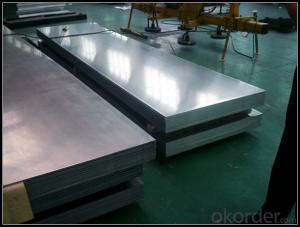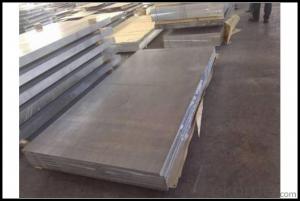Thin Aluminum Sheet Alloy used for Foil Stock
- Loading Port:
- Shanghai
- Payment Terms:
- TT OR LC
- Min Order Qty:
- 5 m.t.
- Supply Capability:
- 100000 m.t./month
OKorder Service Pledge
OKorder Financial Service
You Might Also Like
Item specifice
1.Structure of Thin Aluminum Sheet Alloy used for Foil Stock
Aluminum Sheets are strengthened and cut from raw materials with different alloys, such as AA5005, AA5052, etc. They are easy for processing in different shapes, good in intensity and can be quickly installed. Aluminium Sheets for Energy Saving Curtain Walls are good in energy saving, weather resistance, fire resistance, easy for maintenance and with many colors.
Aluminium Sheets for Energy Saving Curtain Walls are widely used in construction of metal walls, metal ceilings, car decoration, advertizing panels, etc.
2.Main Features of Thin Aluminum Sheet Alloy used for Foil Stock
•High intensity
•Easy to be processed and shaped
•Weather resistance
•Anti-pollution & environment protection
3. Thin Aluminum Sheet Alloy used for Foil Stock Images
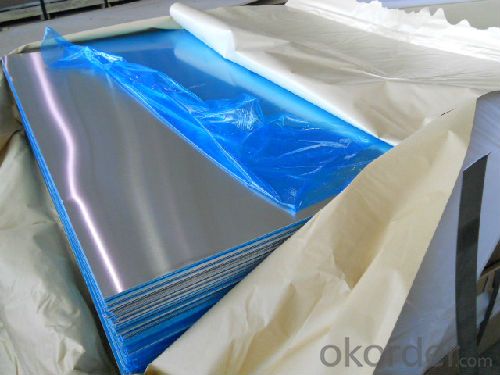
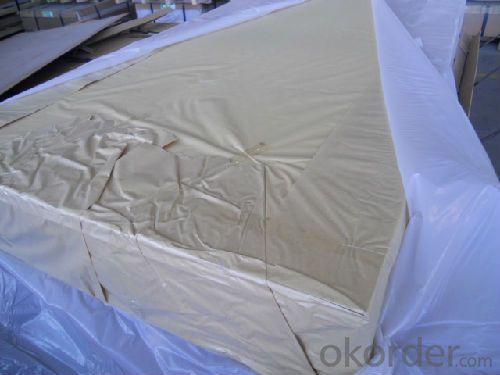
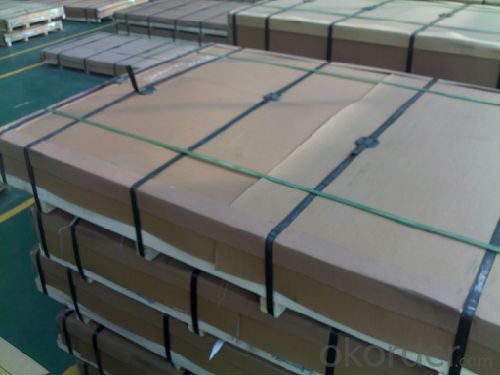
4.Specification of Thin Aluminum Sheet Alloy used for Foil Stock
Alloy Number | AA5XXX |
Temper | H12, H14, H16, H18, H22, H24, H26, H32, HO, F |
Thickness | 0.1mm – 500mm |
Width | 10mm- 2200mm |
Standard | GB/T3880-2006, ASTM, ISO, EU standard |
5.FAQ
A.What about inspections to guarantee quality?
For each order for Aluminum Sheets with Mill Finished Surface AA5XXX, we will arrange strict inspection for raw materials, inspection during production and inspection for finished goods.
With requirement of customers, we also can arrange the third party inspection.
B.What about delivery?
We will put order for Aluminum Sheets with Mill Finished Surface AA5XXX in production schedule after order gets confirmed against copy of TT or L/C. Normally it takes about one month for production. Exact shipment schedule is different based on different sizes and quantity.
C.What is the MOQ?
5 tons for each size.
D. Where have you exported aluminium sheets?
We have exported aluminum sheets to many countries. Main markets include South East Asia, Middle East, North America, South America, etc.
- Q:What is the typical wear resistance of aluminum sheets?
- The typical wear resistance of aluminum sheets can vary depending on the specific alloy and temper of the sheet. Generally, aluminum sheets have a moderate wear resistance compared to other metals. However, they are not as wear-resistant as materials such as steel or titanium. Aluminum sheets can withstand light to moderate wear and abrasion, making them suitable for applications where they are not subjected to excessive friction or impact. To enhance the wear resistance of aluminum sheets, they can be treated with coatings or surface treatments such as anodizing or painting. Additionally, the thickness and hardness of the aluminum sheet can also affect its wear resistance, with thicker and harder sheets generally offering better resistance to wear.
- Q:Are aluminum sheets suitable for architectural applications?
- Yes, aluminum sheets are highly suitable for architectural applications. Aluminum is known for its lightweight yet strong properties, making it ideal for constructing various architectural elements such as roofing, cladding, windows, doors, and façades. It is corrosion-resistant, durable, and offers excellent thermal and electrical conductivity. Additionally, aluminum can be easily formed, bent, and fabricated, allowing architects to create intricate designs and shapes. Its versatility, aesthetic appeal, and sustainability make aluminum sheets a popular choice in the architectural industry.
- Q:What is the maximum size available for aluminum sheets?
- The maximum size available for aluminum sheets can vary depending on the manufacturer and specific requirements. However, aluminum sheets are commonly available in sizes up to 4 feet by 12 feet (48 inches by 144 inches) or even larger. These larger sizes are often used in industries such as construction, aerospace, and automotive manufacturing. It is important to note that custom sizes can also be fabricated based on individual project needs.
- Q:What are the different methods for bending aluminum sheets?
- Depending on the desired outcome and available equipment, there are various techniques for bending aluminum sheets. The following are some commonly used methods: 1. Manual Bending: For smaller projects, the aluminum sheet can be manually bent using a manual brake or bending tool. This can be achieved by hand with the assistance of clamps or a simple bending tool. 2. Press Brake: In industrial settings or for larger-scale projects, a press brake machine is utilized. It applies significant force through a punch and die set to create precise and consistent bends. 3. Roll Bending: To achieve long, continuous bends or curves, the aluminum sheet is passed through a series of rollers in the roll bending method. This technique is commonly employed in the production of cylindrical or conical shapes. 4. Rotary Bending: Thin aluminum sheets are effectively bent into curves using rotary bending. This method involves a rotating roller or wheel along the length of the sheet to create smooth and uniform bends. 5. Heat Bending: Thicker aluminum sheets or complex shapes often require heat bending. The sheet is heated to a specific temperature to enhance its malleability before being bent into the desired shape. It is crucial to consider factors such as aluminum thickness and alloy, desired bend angle and radius, and available equipment when choosing the appropriate bending method. Consulting professionals or referring to specific guidelines is recommended for optimal results.
- Q:Can aluminum sheets be used for architectural facades?
- Architectural facades can indeed utilize aluminum sheets. This versatile material possesses numerous advantages for facade applications. Its lightweight nature, durability, and resistance to corrosion render it suitable for a variety of weather conditions. The fabrication and installation of aluminum sheets are effortless, enabling design flexibility and the creation of intricate and elaborate facades. Moreover, aluminum can undergo various finishes, such as powder coating, anodizing, or painting, to enhance its visual appeal and achieve the desired aesthetic. In summary, employing aluminum sheets for architectural facades empowers architects and designers with an extensive array of options to fashion visually captivating and enduring building exteriors.
- Q:whst should I notice while welding aluminum sheet and aluminum block?
- two types of aluminum reach melting points, aluminum block must be preheated when you weld them with small current, you will know how to do it. You can use argon-arc welding back and forth, preheat it with small current.
- Q:What are the limitations of using aluminum sheet?
- There are several limitations associated with using aluminum sheet in various applications. Firstly, aluminum is a relatively soft metal compared to other options such as steel or titanium. This means that it is more susceptible to scratches, dents, and deformation under heavy loads or impacts. Therefore, it may not be suitable for applications that require high strength or resistance to damage. Secondly, aluminum has lower thermal conductivity compared to other metals. This can be a disadvantage in applications where efficient heat transfer is crucial, such as in heat exchangers or cooling systems. Thirdly, aluminum is prone to corrosion. Although it has a natural oxide layer that provides some protection, it can still corrode in certain environments, especially in the presence of moisture or acidic substances. This limits its use in applications where corrosion resistance is vital, such as marine or chemical industries. Additionally, aluminum is a relatively expensive material compared to other options. Its production and extraction processes require significant energy and resources, contributing to higher costs. Therefore, it may not be the most cost-effective choice for some applications. Lastly, aluminum has limited compatibility with certain substances. It can react with certain chemicals, resulting in degradation or contamination. Therefore, it may not be suitable for applications where it will come into contact with substances that can cause adverse reactions. Overall, while aluminum sheet has numerous advantages such as its lightweight nature, good electrical conductivity, and ease of fabrication, it is important to consider its limitations when selecting it for specific applications.
- Q:Aluminum siding is essentially maintenence-free, extremelydurable, and is a great insulator, even better than brick. Brickleaks air through the mortar between the bricks, especially in olderhouses that need tuckpointing. My question is, do you feel sidingstill has a declasse connotation, or is it getting more acceptableas the years go on?
- No worse than vinyl. The advantage vinyl has over aluminum is its resistance to denting. Siding is a good finish, but if you've already got a brick exterior, you're wasting the hard hours the masons put in to make it. If the brick has deteriorated or is horribly scarred, like having survived a hurricane or tornado, then sure, siding will spiff it up cosmetically as well as adding insulation value. That said, I'd rather take a house with aluminum siding over wood any day...and vinyl over that. If you get the siding in the color you want, as it's the entire thickness of the vinyl, powerwashing the outside won't take the color off as it could with painted wood or (though less likely) the finish on the aluminum...unless you *like* painting :)
- Q:project on aluminum and i cant think of a good/funny slogan for it! HELP! i have already seen the other possibilities on google, try to be unique, and creative! but if you cant just answer the flipping question PLZ!
- Aluminum: Keeping stoners amazed for over 50 years!
- Q:Are aluminum sheets suitable for automotive applications?
- Yes, aluminum sheets are suitable for automotive applications. Aluminum is a lightweight material that offers several advantages for automotive use. Firstly, aluminum is highly corrosion resistant, making it ideal for exterior parts that are exposed to harsh environments. Additionally, aluminum offers great strength-to-weight ratio, meaning it provides high strength while keeping the overall weight of the vehicle low. This leads to improved fuel efficiency and better performance. Aluminum sheets are also easily formable, allowing manufacturers to create complex shapes and designs for various automotive components. Furthermore, aluminum is recyclable, making it an environmentally friendly choice. Overall, the use of aluminum sheets in automotive applications offers numerous benefits, including weight reduction, improved fuel efficiency, corrosion resistance, and design flexibility.
1. Manufacturer Overview |
|
|---|---|
| Location | |
| Year Established | |
| Annual Output Value | |
| Main Markets | |
| Company Certifications | |
2. Manufacturer Certificates |
|
|---|---|
| a) Certification Name | |
| Range | |
| Reference | |
| Validity Period | |
3. Manufacturer Capability |
|
|---|---|
| a)Trade Capacity | |
| Nearest Port | |
| Export Percentage | |
| No.of Employees in Trade Department | |
| Language Spoken: | |
| b)Factory Information | |
| Factory Size: | |
| No. of Production Lines | |
| Contract Manufacturing | |
| Product Price Range | |
Send your message to us
Thin Aluminum Sheet Alloy used for Foil Stock
- Loading Port:
- Shanghai
- Payment Terms:
- TT OR LC
- Min Order Qty:
- 5 m.t.
- Supply Capability:
- 100000 m.t./month
OKorder Service Pledge
OKorder Financial Service
Similar products
New products
Hot products
Hot Searches
Related keywords
